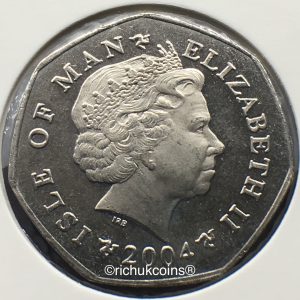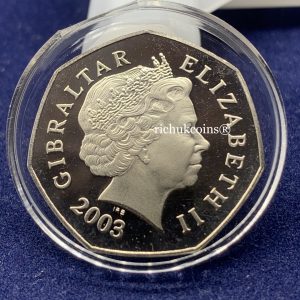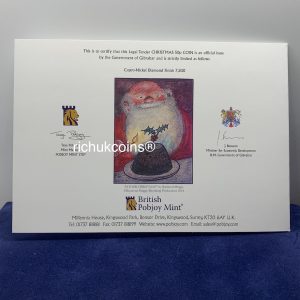Published on
Last Updated on:
Part I
Here, it is a very very interesting topic to present in a way either valuation or numismatic value. This topic also is important to collectors who are keen to Christmas 50p base metal coin in modern British Isles coinage history (other than GB coin). Because the more layers we tear off, the more value you can add on the IOM Xmas series. Frankly, it is only here you are able to find out more information on what actually so-called Diamond Finish is. In the early days (say, pre-1997), a Diamond Finish standard (hereafter DF) is a combination of advanced dies (ie., polished) and advanced planchets (ie., buffed), for instance, 1980 IOM Xmas 50p coin associated with BBs-BC-BD-BE-BFs-BFs(Mule). However, the Isle of Man Christmas 50p coin made after 1999, it let you feel that collectors pay a higher price for low quality item made from normal/advanced Dies and normal blanks.
So, let we introduce a UNC coin without mentioning dies and planchets in detail first, as follows:
- 1999 Christmas 50p Coin from the Isle of Man — UNC <#1>


From the above <#1> pictures, it is hard to tell you what is what, but a base-line point is well established. It is a normal 50p coin which you are able to find it in your pocket money. However, if you look for further detail on the coin, a AA die mark could be spotted at 8 o’clock position. Alongside of that, You are going to see NO squared-rim easily.
Still, another UNC coin, as follows:
- 1999 Christmas 50p Coin from the Isle of Man — UNC <#2>


From the above <#2> pictures, you are going to see more details on the coin compared to UNC <#1>, but this time, a BB die mark noted on at 8 o’clock position and the mirrored-like field. A variant of UNC <#2> named <#2.1> shows a bit low quality in contrast to UNC <#2>, which is associated with no die mark (hereafter ND).
- 1999 Christmas 50p Coin from the Isle of Man — UNC <#2.1>


let we have a close look at obverse each,
- BB’s obverse (UNC <#2>) vs. ND’s obverse (UNC <#2.1>)


At this point, two different coins in grade are established. A UNC <#1> coin is a circulating coin, or Mint Statue (hereafter MS) grade from a 3rd grading company. A UNC either <#2> or <#2.1> coin is a circulating commemorative coin or MS Prooflike.
The last grade in a row, it goes to UNC <#3>.
- 1999 Christmas 50p Coin from the Isle of Man — UNC <#3>


UNC <#3> is also a circulating commemorative coin but a MS Deep PL standard from a 3rd grading company.
Having said that without mentioning dies and planchets, it concludes that most importantly there were no any BUNC 50p coins made in the IOM Xmas series. UNC <#1> was under strike one time and two times for <#2> and <#2.1>, however, three times for UNC <#3>. What is more, the AA and BB die marks were an indication to tell the significant difference between circulating and circulating commemorative coins in principle. However, die marks (with or without) had less information on grades but were able to give you direct information about a xmas coin wether circulating coin or circulating commemorative coin. Obviously, it was hard to follow when the sudden appearance of the existence of ND type of coins. Therefore, UNC (or MS), DF (or MS PL) and DF with Deep prooflike (or MS DPL) were well established and defined here.
A complicated case is list below from the IOM xmas series. UNC and DF coins share the BB die mark at the same time.
- 2000 Christmas 50p Coin from the Isle of Man — UNC <#1>


Yes, a BB die mark is easily spotted, but does not necessarily say it is a UNC <#2> or <#3> coin. The above coin is actually a UNC <#1> coin.
Now, it presents a UNC <#2> and <#2.1> coin as below,
- 2000 Christmas 50p Coin from the Isle of Man — UNC <#2>
- 2000 Christmas 50p Coin from the Isle of Man — UNC <#2.1>




Having said the 1999 IOM Xmas 50p coin mainly, a balanced picture needs to keep in mind. A more complicated case compared cross panel is going to be presented here in relation to same year 50p coin in the IOM Xmas series. we now have to cover the 1999 Xmas 50p coin from Gibraltar (ie., the Mint works on a same topic for two different people, ironically, the Mint has lost the right to mint Gibraltar coinage since 2004). This time, it is your turn to tell us what is it.
- 1999 Christmas 50p Coin from Gibraltar — UNC <#2>? or <#3>?


Do not get me wrong here, the BB die mark does not say or indicate UNC <#2> in grade equally and definitely. What I have talked here is that how to identify a DF standard with and without the die marks.
We are moving to the period of 1999 to 2016 that reveals how the quality of coins drops in years.
First of all, it will be the year 2004 and then 2016 in the second place. There is a pattern of AA-BA-ND in both years when the BA die mark has been used. Meanwhile, the AA die mark is simultaneously existed in relation to the BA die mark as well. Most significantly, the Manx cat in the first place has a farewell appearance in 2004 and drops completely from the IOM Xmas series in 2005. What is more, the p has no place after the 50 denomination in 2016. This echoes back to the very beginning of the IOM Xmas series in 1980. These information are a way to express the internal side of the story.
- 2004 Christmas 50p Coin from the Isle of Man — UNC <#1>
- 2016 Christmas 50p Coin from the Isle of Man — UNC <#1>




The frosting effect can be seen clearly in both. However, in contrast to ND and BA 50p coins made in same years, the above coins are no better in terms of grade and even worse than UNC <#1> from 1999. A assumption is set up here that the two AA die mark coins are very specially made in the first place but reason(s) unknown.
Last, I want to mention a point here that not all AA diemarks stand for UNC or struck on base metal but there is an exception see below.
- 1994 Christmas 50p Silver Proof Coin from Gibraltar — PF <#4>


Credit: NGC database/online
The mystery of the IOM and GIB Xmas 50p coin is not bad and pulling out from the water, but exploring is still on.
#The End



































